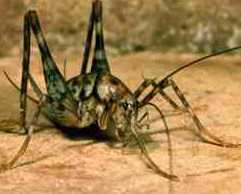Cave Life
 On first sight, caves show little sign of life. Although it's true that most plants cannot achieve a foothold in the complete darkness of caves; many animals, bacteria, and fungi have adapted to this environment and thrive on the organic material carried in by other animals, water and wind.
On first sight, caves show little sign of life. Although it's true that most plants cannot achieve a foothold in the complete darkness of caves; many animals, bacteria, and fungi have adapted to this environment and thrive on the organic material carried in by other animals, water and wind.
Pictured are two inhabitants of the "twilight zone" near cave entrances. The Spotted Cave Salamander (Eurycea lucifuga) is seen singly or in groups hanging to damp walls near cave entrances. They are typically 4-7 inches long, including the tail. Their presence deep in a cave indicates another entrance is nearby, although the entrance may not be large enough to admit a human. Although fairly common in Indiana, this salamander is listed as endangered in a number of other states.
 The Camel Cricket (Ceuthophilus stygius) appears intimidating in this photo, but rarely exceeds an inch in length and is entirely harmless. Camel crickets prefer to hang from the ceiling and, unlike field crickets, do not "chirp." This species is fairly plentiful and can be found outside of caves in just about any moist environment.
The Camel Cricket (Ceuthophilus stygius) appears intimidating in this photo, but rarely exceeds an inch in length and is entirely harmless. Camel crickets prefer to hang from the ceiling and, unlike field crickets, do not "chirp." This species is fairly plentiful and can be found outside of caves in just about any moist environment.
Cricket photo courtesy Dept of Entomology, Clemson University